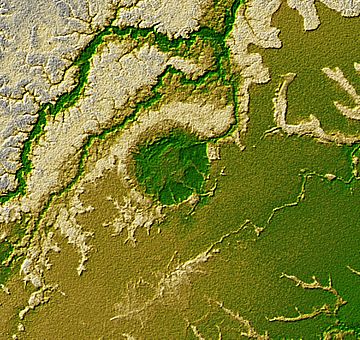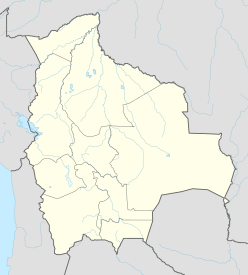Iturralde crater facts for kids
| Araona crater | |

Topographic image generated from Shuttle Radar Topography Mission data over Iturralde crater
|
|
| Impact crater/structure | |
|---|---|
| Confidence | Probable |
| Diameter | 8 km (5.0 mi) |
| Depth | 20 m (66 ft) |
| Age | 11,000 to 30,000 years ago Late Pleistocene |
| Exposed | Yes |
| Drilled | No |
| Bolide type | Air bursting meteorite? |
| Location | |
| Location | Madidi National Park |
| Coordinates | 12°35.2′S 67°40.5′W / 12.5867°S 67.6750°W |
| Country | Bolivia |
| State | La Paz |
| Province | Abel Iturralde |
| Municipality | Ixiamas |
Iturralde Crater, also known as Araona Crater, is a huge circular shape found in the Amazon Rainforest in Bolivia. It's about 8 kilometers (5 miles) wide. Scientists first spotted this interesting feature in 1985 using pictures from Landsat satellites.
The crater is located in a very remote part of Madidi National Park. Researchers visited the site in 2002 to study it up close. They found millions of tiny glass beads there. Scientists believe the crater was formed a long time ago, between 11,000 and 30,000 years ago, during the Pleistocene period. It's thought to have been created by an "air burst" from a meteorite. This is similar to the famous Tunguska event that happened in Siberia in 1908.
Contents
What is the Iturralde Crater?
The Iturralde Crater was first seen in 1985 using images from the Landsat program. It's located between the Manupari and Madidi Rivers. Because of its perfectly round shape, many scientists think it might be a crater made by a meteorite.
The area where it's found has a lot of active rivers. These rivers constantly deposit new soil and sand. This means the crater must be quite young in terms of geology. Experts estimate its age to be between 11,000 and 30,000 years old. Unlike many other young craters, Iturralde is very flat. If it was formed by an impact, it's possible the crater slowly sank into the soft ground. This would leave only a circular "ghost" mark of its original edge.
Exploring the Crater
The Iturralde Crater is in a very hard-to-reach area. Despite this, scientific teams have visited it twice. The most recent visit was in September 2002 by a team from NASA's Goddard Space Flight Center.
During these trips, the researchers looked for clear proof of how the crater was formed. However, they didn't find all the answers right away.
Later, scientists studied the samples collected in 2002. They discovered tiny groups of glass beads deep in the ground. Some of these glass pieces contained hundreds or even thousands of these tiny beads. It's estimated there are millions of these spheres per kilogram of soil. This discovery of glassy material supports the idea that the Iturralde crater was formed by a huge explosion in the air. This explosion would have been caused by an extraterrestrial object.
How an Air Burst Forms a Crater
An "air burst" happens when a space object, like a meteorite, explodes in the atmosphere before it hits the ground. This can happen if the object is small or not very dense, like porous ice or stone. If it's too weak to survive the trip through Earth's atmosphere, it won't create a typical impact crater.
When such an object enters the atmosphere, it moves incredibly fast, sometimes up to 50 kilometers (31 miles) per second. The energy released during this air burst would be huge. It would be even bigger than any known nuclear explosion.
This extreme heat would create powerful air currents. These currents would lift loose material from the ground into the fiery explosion. This material would then melt and fall back to Earth as tiny glass beads. The powerful blast from the air burst could have reached the ground. This would have created the bowl-shaped feature we see today.
See also
 In Spanish: Cráter Iturralde para niños
In Spanish: Cráter Iturralde para niños
- List of possible impact structures on Earth
- Campo del Cielo
- Río Cuarto craters


